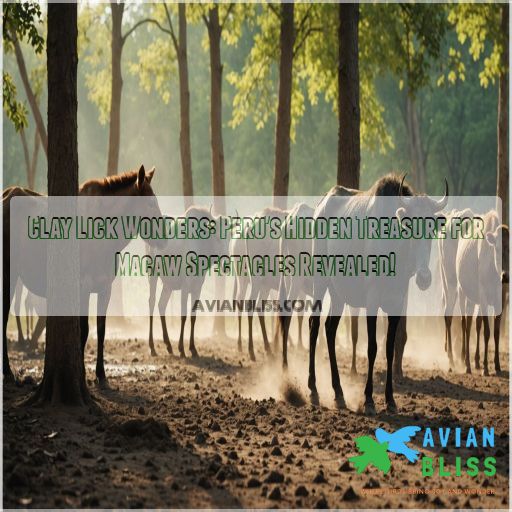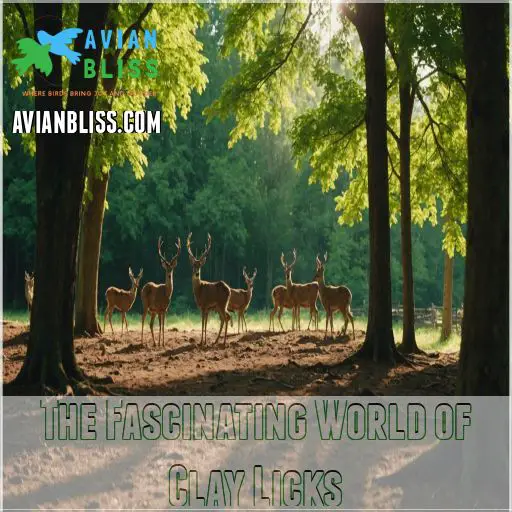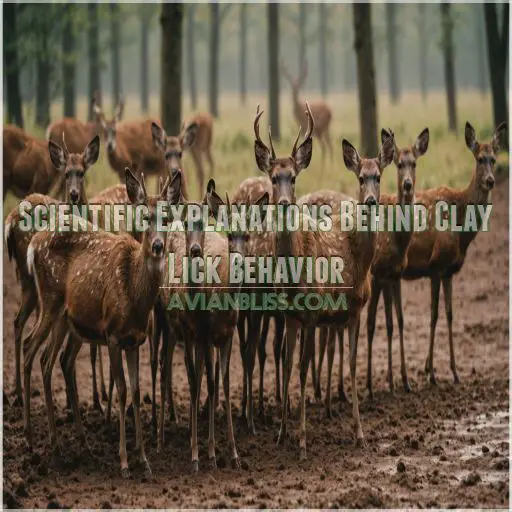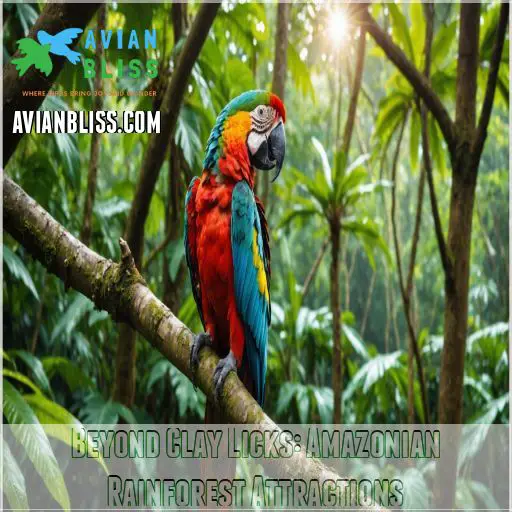This site is supported by our readers. We may earn a commission, at no cost to you, if you purchase through links.

Imagine this: hundreds of vibrant macaws gathering at riverbanks, munching on mineral-rich soil. It’s not just a colorful spectacle; it’s nature’s pharmacy! Clay licks help birds neutralize toxins and get their sodium fix.
From Peru’s tambopata national reserve to Manu National Park, these hotspots are teeming with biodiversity. But it’s not just for the birds – tapirs and primates join the feast too. Who knew eating dirt could be so fascinating? There’s more to these muddy marvels than meets the eye.
Table Of Contents
- Key Takeaways
- The Fascinating World of Clay Licks
- Macaw Clay Licks: a Spectacular Natural Phenomenon
- Scientific Explanations Behind Clay Lick Behavior
- Top Clay Lick Locations in Peru
- Planning Your Clay Lick Experience
- Clay Lick Tours and Accommodations
- Beyond Clay Licks: Amazonian Rainforest Attractions
- Frequently Asked Questions (FAQs)
- What is the benefit of licking clay?
- Why do macaws go to clay Licks?
- What animals use clay licks?
- Why do animals lick clay?
- What safety precautions should visitors take at clay licks?
- How do clay licks impact local ecosystems?
- Are there clay licks outside of South America?
- Can clay licks be artificially created for conservation?
- How has climate change affected clay lick activity?
- Conclusion
Key Takeaways
- You’ll find nature’s own pharmacy in the Amazon rainforest – clay licks serve as mineral-rich buffets where macaws and other wildlife neutralize toxins and get their sodium fix. It’s like a detox spa day for birds.
- You can witness a rainbow explosion at these hotspots, with hundreds of colorful macaws gathering at riverbanks. It’s not just eye candy, though – these clay licks play a crucial role in maintaining the health of Amazonian ecosystems.
- You’ve got options galore when it comes to spotting clay licks in Peru. From the famous Tambopata National Reserve to the hidden gems of Manu National Park, you’ll have front-row seats to one of nature’s most dazzling shows.
- You’re not just a spectator – by visiting clay licks responsibly, you’re contributing to their conservation. It’s a win-win: you get unforgettable memories, and the rainforest gets a helping hand. Just remember to pack your binoculars and leave only footprints.
The Fascinating World of Clay Licks
You’re about to uncover the secrets of Peru’s clay licks, nature’s hidden gems that draw flocks of colorful macaws and other wildlife.
These mineral-rich riverbank deposits aren’t just eye candy – they play a key role in the diet and health of Amazonian animals, offering a unique glimpse into the intricate balance of rainforest ecosystems.
Definition and Purpose of Clay Licks
Clay licks are a fascinating buffet for parrots and other wildlife, serving as nature’s pharmacy.
These exposed soil banks provide essential minerals for detoxification in birds’ diets.
Macaws indulge in these mineral-rich treats, neutralizing toxins and supplementing their sodium intake.
Picture a macaw clay lick like Collpa Chuncho as a vibrant rainforest diner catering to colorful diners, enhancing your wildlife viewing experience.
Geographical Distribution of Clay Licks
You’ll find nature’s hidden buffets scattered across the Amazon, but the southern Peruvian rainforest takes the cake. It’s a clay lick goldmine! The perfect storm of forest type, exposed riverbanks, and the Andes’ position creates an ideal environment. This unique combo has blessed the region with more clay licks than anywhere else in Amazonia, making it a hotspot for wildlife enthusiasts and conservationists alike.
Types of Clay Licks (Macaw, Tapir, Etc.)
While clay licks dot the Amazonian landscape, they’re not all created equal. You’ll find a variety of these natural wonders, each catering to different wildlife:
- Macaw clay licks: Vibrant gatherings of colorful pa
Ecological Importance of Clay Licks
Clay licks punch above their weight in the Amazon’s ecosystem. These natural buffets serve up more than just a tasty treat for wildlife. Check out how these hotspots impact the environment:
| Ecological Role | Impact on Ecosystem |
|---|---|
| Toxin Neutralizer | Helps birds detoxify diet |
| Sodium Source | Addresses mineral deficiencies |
| Biodiversity Hub | Attracts diverse species |
| Health Indicator | Reflects forest ecosystem health |
| Conservation Focus | Drives habitat protection efforts |
Ever wonder why these muddy hangouts are so important? They’re nature’s multivitamins, keeping the rainforest’s residents healthy and happy!
Macaw Clay Licks: a Spectacular Natural Phenomenon
You’re about to witness one of nature’s most dazzling spectacles: macaw clay licks in Peru.
Get ready to be amazed as hundreds of colorful parrots gather at these unique riverbank sites, offering a window into their fascinating behavior and the key role these areas play in their survival.
Macaw Species Frequenting Clay Licks
At Peru’s clay licks, you’ll witness a rainbow of macaw species gathering for their mineral fix.
From the vibrant scarlet macaws to the stunning blue-and-gold beauties, these feathered celebrities put on quite a show.
Red-and-green macaws join the party too, creating a technicolor tapestry against the earthy backdrop.
It’s like nature’s own red carpet event, where every macaw is vying for the spotlight!
Behavioral Patterns at Clay Licks
At the crack of dawn, you’ll witness a mesmerizing spectacle as macaws descend upon clay licks.
These colorful aviators follow a fascinating routine:
- Scout birds arrive first, scanning for predators
- The flock gradually gathers, creating a cacophony of squawks
- A feeding frenzy ensues, with birds
Best Times to Observe Macaw Activity
Two prime seasons await your macaw-watching adventure.
You’ll hit the jackpot during the rainy months (October to March) when fruit abundance skyrockets, drawing in flocks like moths to a flame.
But don’t write off the dry season (April to July) – it’s got its own charm.
With less competition at the clay licks, you might catch a more intimate spectacle of these colorful characters in action.
Conservation Efforts for Clay Lick Habitats
In the face of growing threats, conservation efforts for clay lick habitats have become a top priority.
You’ll find dedicated teams working tirelessly to protect these natural wonders:
- Implementing sustainable tourism practices
- Engaging local communities in preservation efforts
- Launching reforestation projects to expand habitats
By supporting responsible travel, you’re not just checking off a bucket list item; you’re contributing to the long-term survival of these magnificent macaw spectacles.
It’s a win-win for both nature lovers and the colorful creatures that call these clay licks home.
Scientific Explanations Behind Clay Lick Behavior
You might think macaws flock to clay licks just for a tasty snack, but there’s some fascinating science behind their behavior like the vibrant red plumage of male cardinals.
Let’s explore the surprising reasons these colorful birds chow down on clay, from detoxifying their diets to getting essential minerals.
Toxin Neutralization in Bird Diets
You’ve seen the dazzling display of macaws at clay licks, but have you ever wondered why they’re munching on dirt?
It’s not just a quirky habit—it’s a clever survival tactic.
These vibrant birds face a daily challenge: their diet is packed with toxins from seeds and fruits.
Clay ingestion acts as nature’s antacid, neutralizing these harmful compounds in their gut.
Talk about a bird-brained solution that actually works!
Sodium Supplementation for Macaws
While neutralizing toxins is important, macaws also flock to clay licks for another key reason: sodium. These colorful birds crave salt like we crave potato chips! Clay licks serve as nature’s salt shakers, providing essential minerals often scarce in their fruity diets.
At these natural buffets, you’ll witness macaws:
- Perching excitedly on riverbanks
- Pecking at sodium-rich clay
- Socializing with their feathered friends
It’s like a mineral-packed happy hour for these stunning creatures!
Clay Consumption in Other Animal Species
Macaws aren’t the only critters with a taste for clay.
You’ll find a whole menagerie of animals lining up for their mineral fix.
Primates like spider monkeys and howler monkeys are known to munch on soil, while tapirs and peccaries often visit clay licks.
Even some butterflies get in on the action!
It’s like nature’s multivitamin, providing essential minerals and helping with digestion.
Ongoing Research on Clay Lick Benefits
Scientists are digging deeper into the mysteries of clay licks, uncovering fascinating insights.
Researchers at the Tambopata Research Center are analyzing mineral compositions and studying how clay consumption affects macaws’ gut microbiomes.
These findings could revolutionize our understanding of avian health and evolution.
As you plan your Peru adventure, remember that your visit contributes to this groundbreaking research.
Who knows? You might witness a breakthrough in action during your clay lick expedition!
Top Clay Lick Locations in Peru
You’re in for a treat as we explore Peru’s top clay lick locations, where nature’s most spectacular avian shows unfold.
From the famous Tambopata National Reserve to the hidden gems of manu national park and Heath River, you’ll discover where to witness hundreds of colorful macaws in their element.
Tambopata National Reserve Clay Licks
You’ll be blown away by the Tambopata National Reserve clay licks.
These natural wonders are a must-see on your Peruvian adventure.
The famous Chuncho clay lick offers breathtaking views of hundreds of macaws gathering for their daily mineral fix.
Don’t miss the chance to witness this dazzling display of colors and learn about ongoing conservation efforts.
It’s a wildlife encounter you’ll never forget!
Manu National Park Clay Licks
Moving from Tambopata, let’s explore another gem in Peru’s crown. Manu National Park’s clay licks are a treasure trove for bird lovers. Here’s what makes them special:
- Pristine, protected habitats
- Diverse array of macaw species
- Unique tapir clay licks
- Breathtaking rainforest surroundings
- Excellent birdwatching opportunities
Manu National Park’s clay licks are a unique and vibrant spectacle. Imagine yourself perched in a cozy hide, binoculars at the ready, as hundreds of colorful macaws descend upon the clay-rich banks. It’s nature’s own rainbow-hued spectacle, right before your eyes!
Heath River Wildlife Center Clay Licks
Let’s shift our focus to the Heath River Wildlife Center, another gem in Peru’s clay lick crown.
This hidden treasure offers a front-row seat to nature’s spectacle.
You’ll witness macaws in their element, showcasing vibrant behaviors that’ll leave you in awe.
But that’s not all – keep your eyes peeled for tapirs, adding an extra layer of excitement to your wildlife adventure.
It’s a true feast for nature lovers!
Accessibility and Visitor Facilities
After exploring the Heath River’s hidden gems, you’re probably wondering how to reach these spectacular clay licks.
Don’t worry! Most top clay lick locations in Peru are surprisingly accessible.
Tour operators have set up cozy lodges and well-maintained trails, making your journey a breeze.
You’ll find knowledgeable guides, safe transportation, and eco-friendly facilities that minimize environmental impact.
It’s like having a front-row seat to nature’s grandest show, without roughing it too much!
Planning Your Clay Lick Experience
Planning your clay lick adventure in Peru’s Amazon requires a bit of savvy to maximize your chances of witnessing the colorful macaw spectacle.
You’ll want to time your visit right, pack smart, and know a few insider tips to capture those Instagram-worthy shots of hundreds of parrots gathering for their daily mud feast.
Best Seasons for Clay Lick Visits
Now that you’re familiar with Peru’s top clay lick spots, let’s talk timing.
You’ll want to plan your visit during the sweet spot for macaw action.
The rainy season (October to March) is your golden ticket.
Why? More rain means more fruit, and more fruit equals a bird bonanza at the clay licks.
It’s like nature’s all-you-can-eat buffet for our feathered friends!
Recommended Duration of Stay
While you could squeeze in a clay lick visit in a day, you’ll want to savor this natural wonder.
To truly experience the magic, plan for at least 3-5 days.
This Trip Length allows you to witness multiple Clay Lick Varieties and maximize your Wildlife Focus.
Plus, you’ll have time to explore nearby attractions, making your travel stories unforgettable.
Essential Gear and Equipment
Planning to witness the macaw spectacle? Don’t forget to pack your adventure essentials!
You’ll want a trusty pair of binoculars to catch every colorful detail.
Dress for success in lightweight, breathable clothing and sturdy hiking boots.
Bug spray is your best friend in the jungle – trust me, those mosquitoes mean business!
And of course, bring your camera to capture the memories.
You’re all set for an unforgettable clay lick experience!
Photography Tips at Clay Licks
You’ve got your gear packed, but are you ready to capture those unforgettable macaw moments? Here’s how to snap jaw-dropping photos at clay licks:
- Master your camera settings for low-light conditions
- Frame your shots to showcase the vibrant colors and dramatic flight patterns
- Practice ethical photography to avoid disturbing the birds
Clay Lick Tours and Accommodations
Ready to witness the breathtaking spectacle of macaws at clay licks?
You’re in luck – Peru offers some of the best tours and accommodations to get you up close and personal with these colorful avian gatherings.
Tambopata Research Center Offerings
The Tambopata Research Center offers a front-row seat to nature’s greatest show.
You’ll be in macaw heaven, with access to two jaw-dropping clay licks: Colorado and Chuncho.
Rub elbows with researchers studying these colorful characters, and soak in expert insights.
After a day of wildlife encounters, unwind in comfortable lodgings nestled deep within the Amazon’s biodiversity hotspot.
Manu Wildlife Center Experiences
At Manu Wildlife Center, you’ll get right into the heart of the Amazonian rainforest.
This hidden gem offers a smorgasbord of wildlife experiences:
- Jaguar sightings (10% chance!)
- Bird diversity that’ll make your binoculars swoon
- Tapir clay licks for night owl adventures
You’ll feel like a seasoned travel writer as you snap photos of scarlet macaws against the lush backdrop. It’s not just a trip; it’s a ticket to nature’s greatest show!
Guided Tour Options and Itineraries
Now that you’ve explored Manu Wildlife Center, let’s map out your clay lick adventure. Guided tours offer a smorgasbord of options to suit your travel goals.
Whether you’re a budget-conscious backpacker or a luxury-seeking globetrotter, there’s a perfect fit.
Tour durations range from quick day trips to week-long expeditions. Small group sizes guarantee intimate experiences, while expert guides weave travel tales that’ll ignite your wanderlust and create unforgettable travel memories.
Eco-friendly Lodges Near Clay Licks
You’ve explored the tours, now let’s talk about where you’ll rest your head. Eco-friendly lodges near clay licks offer more than just a comfy bed. These sustainable havens are your gateway to responsible travel in South America.
Imagine waking up to the sounds of the rainforest, knowing your stay supports local communities and conservation efforts. It’s like having your cake and eating it too – adventure with a conscience!
Beyond Clay Licks: Amazonian Rainforest Attractions
While clay licks are a major draw, you’ll find the Amazon has even more wonders up its sleeve.
From diverse wildlife encounters to immersive cultural experiences, your Peruvian adventure is just getting started.
Wildlife Diversity in Surrounding Areas
Stepping beyond the clay licks, you’ll find yourself immersed in a vibrant tapestry of Amazonian wildlife.
From curious capuchin monkeys swinging through the canopy to elusive jaguars prowling the forest floor, the surrounding areas teem with life.
Keep your eyes peeled for colorful toucans, lazy sloths, and playful river otters.
It’s a birdwatcher’s paradise and a wildlife photographer’s dream come true.
Jungle Trekking and Night Walks
Venturing beyond clay licks, jungle treks and night walks offer thrilling encounters with Amazonian wildlife.
You’ll navigate lush trails, spotting colorful birds and elusive mammals by day.
As darkness falls, the rainforest transforms.
Armed with flashlights, you’ll discover a nocturnal world teeming with life. Listen for mysterious calls and watch for glowing eyes in the foliage.
Don’t forget your camera – you’ll want to capture these unforgettable moments!
River Excursions and Fishing Activities
After your nighttime jungle adventure, it’s time to hit the water!
River excursions offer a thrilling way to explore the Amazon’s aquatic wonders.
Try your hand at piranha fishing (don’t worry, it’s safer than it sounds!) or learn sustainable Amazonian fishing techniques.
Keep your eyes peeled for river dolphins, caimans, and other fascinating creatures.
These waterborne adventures will make you feel like a true Amazon explorer!
Cultural Experiences With Local Communities
While exploring the Amazon’s wonders, you’ll find treasures beyond the clay licks.
Local communities offer a window into centuries-old traditions and Indigenous wisdom. You can try your hand at traditional crafts, learn about medicinal plants, or join a community feast.
These cultural exchanges enrich your journey but also support sustainable tourism practices. It’s a chance to connect with the heart of the rainforest and its people.
Frequently Asked Questions (FAQs)
What is the benefit of licking clay?
You’d be astonished by clay’s superpowers! It’s your stomach’s best friend, neutralizing toxins from your diet like a magician.
Plus, it’s a sodium goldmine for your body when you’re craving that salty goodness.
Who knew dirt could be so helpful?
Why do macaws go to clay Licks?
Macaws visit clay licks to neutralize toxins from their diet and obtain essential sodium.
They’re drawn to these natural buffets, where they feast on mineral-rich clay.
It’s like nature’s pharmacy for these colorful birds, a crucial source of carotenoids!
What animals use clay licks?
Imagine a tapir lumbering up to a muddy bank.
You’ll find an array of creatures at clay licks, from colorful macaws to capybaras.
Parrots, parakeets, monkeys, and peccaries also frequent these mineral-rich spots for their salty fix.
Why do animals lick clay?
Animals lick clay to neutralize toxins in their diet and obtain essential minerals.
It’s like nature’s antacid, binding to harmful substances in their gut.
This clever trick helps them stay healthy while enjoying a varied menu.
What safety precautions should visitors take at clay licks?
Like a seasoned explorer, you’ll want to tread lightly.
Stay quiet, keep your distance, and follow guide instructions.
Don’t feed or disturb wildlife.
Wear muted colors and bring binoculars for safe, up-close views of nature’s spectacle.
How do clay licks impact local ecosystems?
You’ll find clay licks serve as important mineral sources, supporting diverse wildlife.
They’re essential for detoxification and sodium intake, particularly for parrots and macaws.
This nutrient hub fosters biodiversity, attracting various species and maintaining ecological balance.
Are there clay licks outside of South America?
While South America’s famous, you’re not limited to the Amazon for clay licks. They’re scattered globally, from Papua New Guinea to Africa.
These mineral-rich spots attract diverse wildlife, offering nature lovers worldwide a chance to witness this fascinating phenomenon.
Can clay licks be artificially created for conservation?
Artificial clay licks can be created for conservation, but it’s tricky.
You’d need to mimic natural soil composition and placement.
Some zoos have successfully implemented them, offering hope for wildlife preservation in captivity and rehabilitation programs.
How has climate change affected clay lick activity?
Climate change has impacted clay lick activity in a major way.
Rising temperatures and altered rainfall patterns disrupt fruit availability, affecting macaw diets and clay consumption.
Researchers are studying these shifts to better understand long-term consequences for rainforest ecosystems.
Conclusion
Did you know that over 17 species of parrots have been spotted at a single clay lick? That’s nature’s version of a bustling buffet!
Peru’s clay licks aren’t just feeding grounds; they’re windows into the Amazon’s vibrant ecosystem.
Whether you’re a birdwatcher, photographer, or nature enthusiast, witnessing a clay lick spectacle is unforgettable.
So pack your binoculars and sense of wonder – Peru’s hidden treasures await. You’ll leave with colorful memories and a newfound appreciation for the key role clay licks play in rainforest life.










